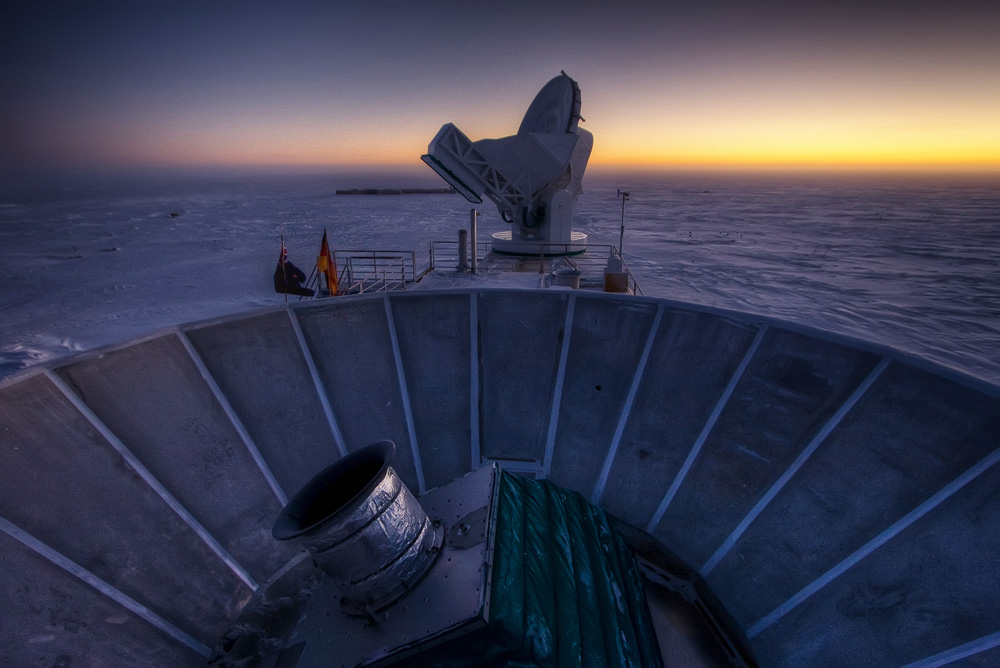|
Clear signalTelescope at South Pole detects 'smoking gun' signature of cosmic inflationPosted March 18, 2014
Researchers with the BICEP2 Inflation is the cataclysmic event in which, in a fleeting fraction of a second following the Big Bang Modern astronomy is built around the theory that almost 14 billion years ago, the universe burst into existence in an extraordinary event called the Big Bang, which was then followed by the superluminal inflation of space-time that created the current universe as we know it. But until the BICEP results were announced, all of the scientific conjecture on inflation was built solely on a solid theoretical framework. Now, using data gathered by an National Science Foundation 
Photo Credit: Peter Rejcek
Physicist Justus Brevik works in the BICEP2 telescope control room in the Dark Sector Lab at the South Pole Station in this 2011 photo.
The findings, the collaboration’s researchers believe, also represent the first images of gravitational waves or ripples in space-time, and confirm a deep connection between quantum mechanics and general relativity. These waves have been described as the “first tremors of the Big Bang.” “Detecting this signal is one of the most important goals in cosmology today. A lot of work by a lot of people has led up to this point,” said John Kovac Through the Division of Polar Programs, NSF manages the U.S. Antarctic Program The results were announced at a press conference at 11:55 a.m. Monday, March 17. A technical presentation preceded the press conference. BICEP2 is the second stage of the NSF-funded collaborative program. Harvard University In addition to Kovac, the NSF-funded principal investigators for the BICEP2 project are Clem Pryke Photo Credit: Peter Rejcek/Antarctic Photo Library
Principal investigator John Kovac for BICEP2 works on a receiver for another telescope at the South Pole Station designed to look at cosmic inflation.
Other major collaborating institutions for BICEP2 include the University of California, San Diego In addition to NSF support for BICEP, NASA’s The team examined spatial scales on the sky spanning about one to five degrees (two to ten times the width of the full moon). They traveled to the South Pole Station to take advantage of the cold, dry, stable air over Antarctica’s polar plateau, which rises thousands of meters above sea level. “The South Pole is the closest you can get to space and still be on the ground,” Kovac said. “It’s one of the driest and clearest locations on Earth, perfect for observing the faint microwaves from the Big Bang.” The groundbreaking results came from observations by the BICEP2 telescope of the cosmic microwave background (CMB) For example, small differences in temperature across the sky show where parts of the universe were denser, eventually condensing into galaxies and galactic clusters. Photo Credit: Keith Vanderlinde/Antarctic Photo Library
An aurora shimmers above the South Pole Station building that held the BICEP2 telescope.
Since the CMB is a form of light, it exhibits all the properties of light, including polarization. On Earth, sunlight is scattered by the atmosphere and becomes polarized, which is why polarized sunglasses help reduce glare. In space, the CMB was scattered by atoms and electrons and became polarized, too. “Our team hunted for a special type of polarization called ‘B-modes,’ which represents a twisting or ‘curl’ pattern in the polarized orientations of the ancient light,” Bock said. Gravitational waves squeeze space as they travel, and this squeezing produces a distinct pattern in the CMB. Gravitational waves have a ‘handedness,’ much like light waves, and can have left- and right-handed polarizations. “The swirly B-mode pattern is a unique signature of gravitational waves because of their handedness. This is the first direct image of gravitational waves across the primordial sky,” Kuo said. The researchers were surprised to detect a B-mode polarization signal considerably stronger than many cosmologists expected. The team analyzed their data for more than three years in an effort to rule out any errors. They also considered whether dust in our galaxy could produce the observed pattern, but the data suggest this is highly unlikely. “This has been like looking for a needle in a haystack, but instead we found a crowbar,” Pryke said. Vladimir Papitashvili, the U.S. Antarctic Program’s Astrophysics and Geospace sciences program Asked to comment on the implications of this discovery, Harvard theorist Avi Loeb said, “This work offers new insights into some of our most basic questions: Why do we exist? How did the universe begin? These results are not only a smoking gun for inflation, they also tell us when inflation took place and how powerful the process was.” Technical details and journal papers can be found on the BICEP2 release website |



For USAP Participants |
For The Public |
For Researchers and EducatorsContact UsNational Science FoundationOffice of Polar Programs Geosciences Directorate 2415 Eisenhower Avenue, Suite W7100 Alexandria, VA 22314 Sign up for the NSF Office of Polar Programs newsletter and events. Feedback Form |


